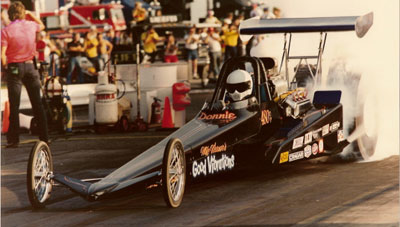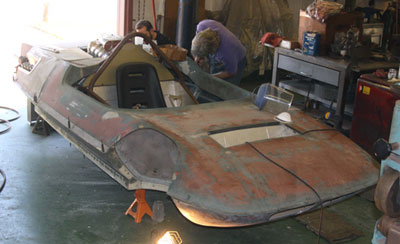

All wedges, all the time ...
Ho hum. Another week, and still more loose threads from the wedge discussion. Sorry for today's late-week posting and that this will be the week's only entry; the work overload on National DRAGSTER has been smothering with no letup in sight, but I wanted to keep the engine running, so to speak.
I have some follow-up on the Dunn & Kruse "Top Fueler" mentioned here last time after exchanging e-mails with Kruse, and I plan to give him a call.
Below is an interesting photo of the "two cars" on the track. There were not two chassis, but rather this is a clever double exposure by Barry Wiggins, taken at OCIR after the Grand Am event (and after the dragster body was painted).
 |
Kruse had been sharing information on the car with the nostalgia-oriented Standard 1320 newsgroup, and I asked permission to reprint his comments here, which he granted. Some of what he said backs up Jim Dunn's comments but with more detail about the actual construction of the car and its rather rushed-into-service nature.
"This version was not meant to be the ideal streamliner; it made use of 'available material' in the form of the Dunn & Reath car with the Funny Car body removed. Initially, the unit was to be used as a plug to make a mold, then lightweight parts were to be built for a competition body. When it was announced that the Jocko/Garlits streamliner would be at OCIR, a decision was made to finish the mock-up unit and race it. It was a little heavier than preferred, but we were inspired by the drama of TWO streamliners at one event.
"The center body between the wheels is .060 aluminum," he wrote. "The fenders were first shaped from block urethane foam, then covered with three layers of fiberglass, riveted on the overlap. The front and rear active control wings are aluminum. The streamliner body was at the racetrack, on the chassis, and qualified for eliminations 17 days after construction started.
"The whole episode was very exciting," he remarked. "The best thing I learned is that the market for streamlined dragsters is very small."

 |
Reader Robert Flitsch offered up "another fire starter for the dreaded wedge discussion" – his description, not mine – with this photo of a black Top Fueler. I recognized the name on the cockpit – Donnie – as probably being Southwest racer Donnie Souter, which I verified through checking the permanent number on the car (480) against other shots of Souter's car. When I first opened this pic, I thought, "Well, that's the Sammy Miller car," but upon closer examination, it's not the same car. Close, but not quite. Miller's car had an enclosed back end, and this one clearly does not. This car also appears to be longer than the Miller car and has a different nosepiece. The Houston-based Souter clan ran Top Fuelers for about 10 years, from the early 1970s to early 1980s, and I'm guessing this photo was a mid-1970s effort.

I've been inundated with suggestions of other "wedge" cars, some of which probably fit loosely in the category and others that don't. Mike Gayowski suggested Gary Ormsby's streamliner, Gene Snow's mid-1980s Top Fueler, and Joe Amato's wingless Top Fueler. With Ormsby's car – which the team billed as a streamliner – I'm almost more convinced to call it a wedge. Again, to me, a streamliner would have an enclosed front end (which his 1986 car did not, but the next version did to a degree) and an enclosed cockpit, which his did not, though it certainly was part of the bodywork. Amato's car was more precisely a ground-effects car; it was his conventional car minus the wind but with a tunnel under the chassis. I saw it make one run in Houston, and it seemed to run just fine, but to my knowledge, that was the only time that he ran it. Amato did also briefly have a streamliner, but I don't think that's what Mike is referencing. Robert Sutton, son of Hall of Fame starter Larry, asked about Cyril Leon's Top Alcohol Dragster from the 1980s. It's a car that I remember seeing, too, but cannot find in our files.
 |
Snow's car, on the other hand, looked like a modern-day wedge. I found this photo from the 1987 Allstars event in Dallas. He didn't qualify there, but the caption said that this was his existing Gene Gaddy-built dragster with the bodywork added and not a from-scratch car. Looking through Snow's file, his dragster underwent a dizzying array of changes and accoutrements, including cockpit canopies, canard wings, and such. I even remember – but cannot find photos of -- crazy devices attached to the headers to increase downforce.

 |
Combing through older e-mails, I found photos that our old pal Steve Reyes sent that show the restoration of the famed AMT Piranha "Funny Car" that was more a wedge Top Fueler than anything as you can see from the photo here, which Reyes took about a month ago.
I've been a little reluctant to head backward in time with the wedge discussion because a) this disucssion originally centered around early-1970s "true" wedge dragsters and b) I'm not sure what worms will crawl from that can, but after poking around a little and reading up on the history of this car, which ran in 1966 and whose roots came from an actual limited-edition production car made of plastic material and whose street-driven "brother" appeared in the 1960s TV spy show The Man from U.N.C.L.E., I think it's definitely worth sharing, which I will do next week.
Until then ...



















































